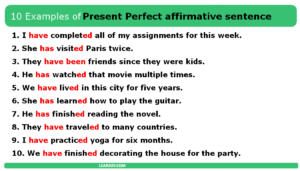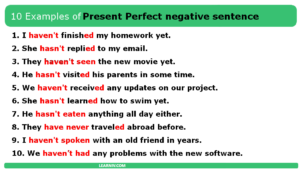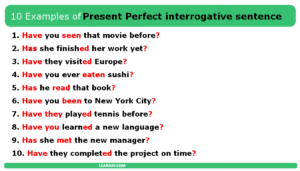The English language offers a variety of verb forms and tenses to accurately express different actions and states. One of these essential tenses is the Present Perfect. Understanding how it works, along with the differences between irregular and regular verbs, is crucial for effective communication. In this article, we will explore the Present Perfect tense, its formation, and provide examples of irregular and regular verbs.
The Present Perfect tense is used to describe actions or states that have a connection to the present, despite occurring in the past. It highlights the outcome or impact of the action rather than specifying the exact time it took place. To form the Present Perfect tense, we use the auxiliary verbs “have” or “has”, followed by the past participle of the main verb.
Differences between irregular and regular verbs
Now, let’s delve into the differences between irregular and regular verbs. Regular verbs follow a predictable pattern when forming their past tense and past participle forms. They usually add “-ed” or “-d” to the base form of the verb. For example, the regular verb “walk” becomes “walked” in the past tense and “walked” in the past participle form.
On the other hand, irregular verbs do not follow this predictable pattern. They have unique past tense and past participle forms that often do not conform to regular conjugation rules. For instance, the irregular verb “go” becomes “went” in the past tense and “gone” in the past participle form.
To help you grasp the concept better, here is a list of commonly used irregular and regular verbs:
Irregular Verbs:
- eat – ate – eaten
- drink – drank – drunk
- take – took – taken
- give – gave – given
- see – saw – seen
- go – went – gone
- do – did – done
- come – came – come
Regular Verbs:
- work – worked – worked
- play – played – played
- talk – talked – talked
- live – lived – lived
- study – studied – studied
- visit – visited – visited
- watch – watched – watched
By familiarizing yourself with both irregular and regular verbs, you can construct grammatically correct sentences and convey your intended meaning accurately. Remember that irregular verbs require memorization since their forms differ from the regular patterns.
It is worth noting that the choice between irregular and regular verbs depends on the verb itself. While some verbs follow regular patterns, others are irregular and require specific forms to be used correctly.
Present Perfect irregular verbs list
Here’s a table with the top 10 irregular verbs, including their infinitive form, past form, past participle form, and present perfect form with “have”:
| Infinitive | Past Form | Past Participle | Present Perfect Form |
|---|---|---|---|
| go | went | gone | have/has gone |
| be | was/were | been | have/has been |
| have | had | had | have/has had |
| do | did | done | have/has done |
| say | said | said | have/has said |
| make | made | made | have/has made |
| see | saw | seen | have/has seen |
| give | gave | given | have/has given |
| take | took | taken | have/has taken |
| come | came | come | have/has come |
These irregular verbs have unique forms for their past tense and past participle, which don’t follow the regular patterns of adding “-ed” or “-d” like regular verbs do. When using them in the present perfect tense, we combine the helping verb “have” or “has” with the past participle form of the verb.
Note: The present perfect form can change based on the subject. We use “have” with pronouns like “I,” “you,” “we,” and “they,” and “has” with the pronouns “he,” “she,” and “it.”
I hope this table helps you understand the different forms of these irregular verbs in the present perfect tense!
Present Perfect regular verbs list
Here’s a table with the top 10 regular verbs, including their infinitive form, past form, past participle form, and present perfect form with “have”:
| Infinitive | Past Form | Past Participle | Present Perfect Form |
|---|---|---|---|
| walk | walked | walked | have/has walked |
| talk | talked | talked | have/has talked |
| play | played | played | have/has played |
| ask | asked | asked | have/has asked |
| love | loved | loved | have/has loved |
| watch | watched | watched | have/has watched |
| cook | cooked | cooked | have/has cooked |
| study | studied | studied | have/has studied |
| call | called | called | have/has called |
| visit | visited | visited | have/has visited |
These regular verbs follow the typical pattern of adding “-ed” to the base form to form the past tense and past participle. When using them in the present perfect tense, we combine the helping verb “have” or “has” with the past participle form of the verb.
Remember that the present perfect form can change based on the subject. We use “have” with pronouns like “I,” “you,” “we,” and “they,” and “has” with the pronouns “he,” “she,” and “it.”
I hope this table helps you understand the different forms of these regular verbs in the present perfect tense!
In conclusion, understanding the Present Perfect tense and the distinctions between irregular and regular verbs is fundamental to expressing actions and states that have relevance to the present. Regular verbs follow a predictable pattern when forming their past tense and past participle forms, while irregular verbs have unique forms that do not conform to regular rules. By incorporating these verbs into your language repertoire, you can effectively communicate in the Present Perfect tense and express a wide range of ideas and experiences.
More examples of Present Perfect sentences
Other examples:
- 5 examples of sentences of Present Perfect tense
- 10 examples of sentences of Present Perfect tense
- 20 examples of sentences of Present Perfect tense
- 50 examples of sentences of Present Perfect tense


